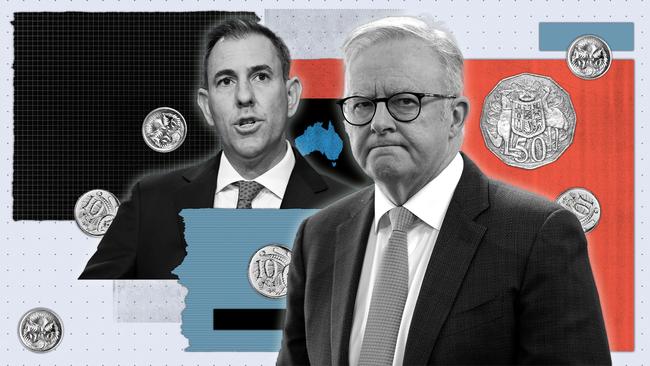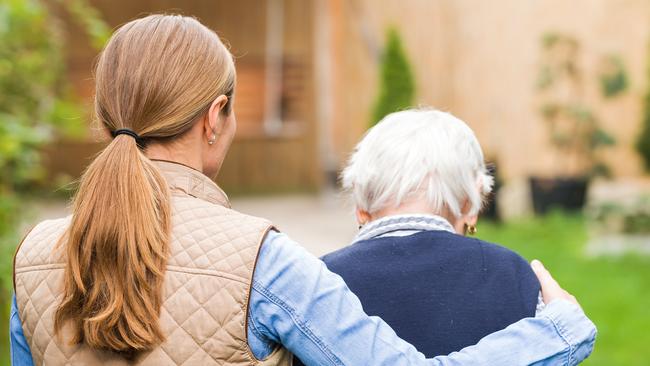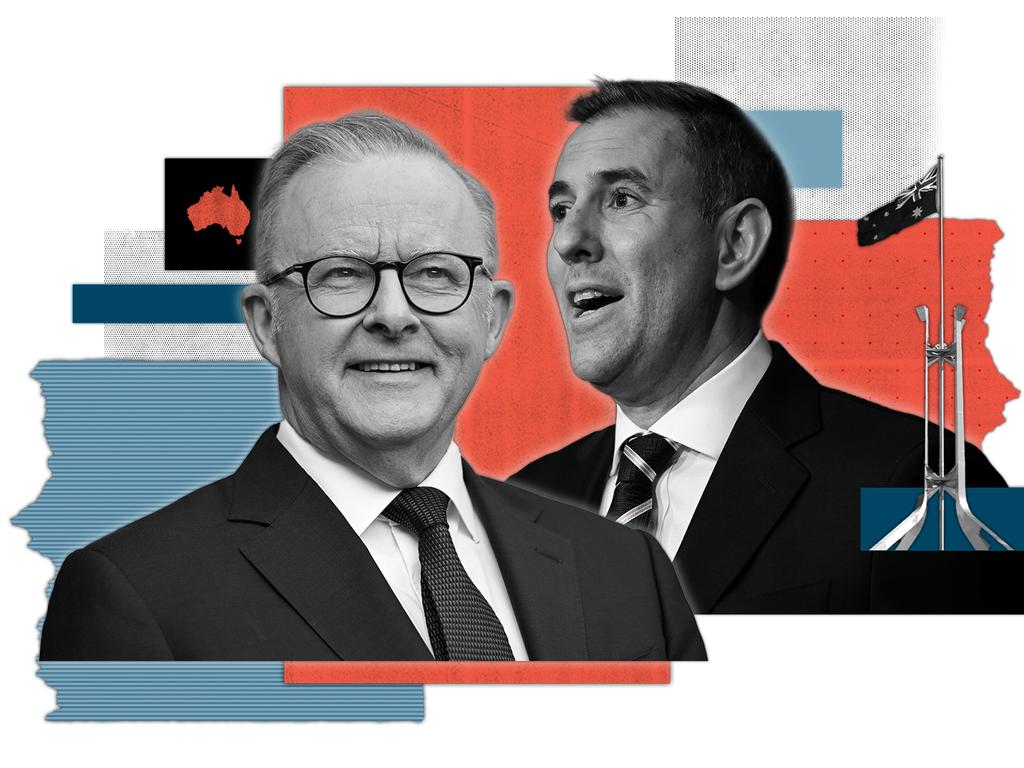Federal Budget 2025: Tax cuts of ‘$5 a week’ isn’t real reform
Labor has unveiled a $5 per week tax cut as the centrepiece of its cost-of-living measure, which will deliver just $268 in savings in its first year beginning in July 2026.

A $5-a-week tax cut beginning in July next year is the centrepiece cost-of-living measure in Jim Chalmers’ fourth budget, with the Albanese government also spending taxpayer funds to lower the costs of electricity bills, medicines and doctor visits.
The Treasurer on Tuesday night revealed workers would receive a tax cut of up to $268 a year in the 2026-27 financial year, with this doubling to $10 a week the following year.
Dr Chalmers said the tax cuts were “modest but will make a difference”.
“The average earner will have an extra $536 in their pocket each year when they’re fully implemented,” he said.
See more of The Australian’s federal budget coverage here.
On top of the revamped stage three tax cuts delivered in last year’s budget, Dr Chalmers said the average worker would be about $50 a week better off than before Labor was elected.
This is despite the Coalition claiming bracket creep had made the average worker $3500 worse off since the Albanese government was elected, even taking into account the impact of stage three.
Under the package unveiled by Dr Chalmers on Tuesday night, the rate of tax for every dollar earned between $18,200 and $45,000 falls from 16 per cent to 15 per cent in July 2026.
It falls again to 14 per cent in July 2027, costing the budget $7.4bn that financial year.
“These new tax cuts return bracket creep by lowering average tax rates for all taxpayers, especially for low- and middle-income earners,” the budget papers say.
Anthony Albanese over the weekend revealed the budget would include a six-month extension of electricity rebates, with each household and small business to receive a $150 discount on their bill between July and December.
Despite the Albanese government failing to meet its pre-election pledge to lower electricity prices by $275, Dr Chalmers said rebates pushed energy bills down by 25 per cent last year.
In an aim to downplay Labor’s responsibility for electricity price increases, Dr Chalmers said energy prices were “putting pressure on households around the world”.
“Two rounds of energy rebates have helped take some of the sting out of energy costs. Tonight, we’re providing $1.8bn more energy bill relief,” he said.
“Every household and around one million small businesses will receive energy rebates until the end of 2025.”
Dr Chalmers said addressing the cost of living was “front and centre in the budget”, with a string of measures being linked to the Albanese government’s aim of taking pressure off households.
This includes spending $8.5bn over the next four years to expand access to taxpayer-funded doctor visits, and funding to reduce the maximum price of a Pharmaceutical Benefit Scheme script from $31.60 to $25.
“Pensioners and concession cardholders will still pay $7.70 a script because we froze their costs as well,” Dr Chalmers said.
“We’re also investing $1.8bn to list more life-changing and life saving medicines on the PBS.
“The Pharmaceutical Benefits Scheme is a great Labor creation and a great Australian institution.
“We are strengthening it because Australians need us to, not weakening it because American multinationals want us to.
“A Labor government created Medicare as well and only Labor governments strengthen it.”
Other measures Labor says is helping with the cost of living include $2.6bn for taxpayer-funded pay rises for aged care workers, a $16bn election promise to forgive 20 per cent of student debts and locking in 100,000 free TAFE places.
“At the core of our economic plan – and the very heart of our Labor government – is a simple objective: to ensure more Australians earn more and keep more of what they earn,” Dr Chalmers said.
Housing help, student debt cuts a ‘fairer’ deal
By Lily McCaffrey
Twenty per cent off student debt, an upgraded shared housing ownership scheme, tax cuts and energy bill relief are among key budget measures Labor hopes will appeal to young voters frustrated by the cost of living and locked out of the housing market.
In line with the government’s November announcement, the government is set to wipe $16bn from the student loan accounts of three million Australians, with all students set to have 20 per cent cut from their debts.
As part of what the government says is a “fairer” student loan repayment system, it will also increase the income threshold for repayment from $54,435 in 2024-25 to $67,000 in 2025-26, and lower compulsory repayment rates for those earning less than $180,000 per year.
In a bid to support young Australians to buy homes with lower deposits and smaller mortgages, the government will put $800m towards expanding its shared-equity Help to Buy program.
Under the changes, more young Australians will be eligible for the program – in which the government makes an equity contribution of up to 40 per cent – with the government increasing maximum income eligibility caps from $90,000 to $100,000 for singles and $120,000 to $160,000 for joint applications.
The government estimates the expanded program – which will also lift maximum property price eligibility caps – will help about 40,000 Australian households locked out of home ownership.
Other cost-of-living relief measures young Australians will benefit from include an extension of energy bill rebates, which will be $75 per quarter until December 31, and the tax cuts, which Dr Chalmers said would take the first tax rate down to its lowest level in more than half a century.
The government has continued its investment in TAFE support, which it says it will make “permanent” by funding 100,000 free TAFE places annually from January 2027.
Other budget measures likely to appeal to young Australians include cheaper medicines, to be capped at $25 for those on the Pharmaceutical Benefits Scheme, and the $8.5bn investment in Medicare.
The government will also support first-home buyers by banning foreign investors from buying established homes, and crack down on foreign land banking, which it says will help “ease pressure on the housing market”.
In his budget speech, Jim Chalmers said the government was “tackling the housing shortage from every responsible angle” to make home ownership more affordable for young Australians, including by investing $54m to “accelerate the uptake of modern methods of construction”.
The move comes as the federal government’s National Housing Accord, which promises 1.2 million new homes by mid-2029, remains behind target.
“Our $33bn plan will help build 1.2 million new homes before the decade is out,” Dr Chalmers said.
Assistance for elderly in pitch for grey vote
By Lily McCaffrey

Aged care nurses and pensioners are at the centre of Labor’s attempts to woo the votes of the elderly and their carers.
While it’s not mentioned in the budget papers, Social Services Minister Amanda Rishworth confirmed before the budget that Labor would maintain its freeze on the deeming rate, a move that will hold significant appeal for many pensioners.
The deeming rate – which is the rate of return the government deems retirees have made on their investments for pension assessment purposes – will remain unchanged at 2.25 per cent, the level it has been at since 2021.
Some $2.6bn of the budget outlays will go towards delivering a further pay rise for 60,000 aged care nurses, which the government says will support the aged care sector to “deliver high-quality care for older Australians”.
In his budget speech, Dr Chalmers said the pay rise would enable “the workers we trust to care for our parents and grandparents will get paid properly for the work they do”.
In terms of cost-of-living relief, older Australians who are living at home will be able to take advantage of the government’s extension of its energy bill relief rebate scheme.

The government has committed $1.8bn to extend the program – which provides households and small businesses with energy bill rebates of $75 per quarter – to the end of this year.
In his budget speech, Dr Chalmers also pledged that the government would use the powers and penalties of the energy regulators and the Australian Competition and Consumer Commission to help ensure pensioners receive the energy discounts they are entitled to.
The government has put $291.6m in the budget to continue delivering its landmark aged care reforms and the implementation of recommendations from the Royal Commission into Aged Care Quality and Safety.
The royal commission released its final report in March 2021 and the new Aged Care Act, which was introduced in response to the royal commission’s recommendations, is due to commence on July 1.
The government will also provide cost-of-living relief to pensioners and seniors by increasing the Medicare levy low-income threshold, which it says will ensure low-income individuals continue to be exempt from paying the levy or pay it at a reduced rate.
For single seniors and pensioners, the threshold will be increased from $41,089 to $43,020, while the family threshold for seniors and pensioners will be increased from $57,198 to $59,886.
Broad boost for gender equality
By Joanna Panagopoulos
Women will receive hundreds of millions of dollars over the next five years for improved access to medical treatments, a bolstered criminal justice system that aims to better protect them, and domestic violence services for First Nations communities.
“Modest” tax cuts are also aimed at low-income and part-time workers, who are predominantly women, the budget papers note, as well as female participation in the workforce.
The government’s combined tax cuts are expected to increase women’s labour supply by 900,000 hours a week compared to 2023-24, which makes up the majority of the approximately 1.3 million excess hours per week expected across the board.
The budget describes ending gender-based violence as a priority to advance equality, with over $21m over three years to improve “victim and survivor engagement in the justice system”.
It is part of a $4bn package to address gender-based violence that has been committed so far by the Albanese government.
There is also close to $22m allocated over the next two years for family, domestic and sexual violence services for First Nations women, children and communities as part of Closing the Gap investment, and $2.5m for emergency accommodation for women and children experiencing family, domestic and sexual violence.
The 2025-26 budget will also provide $842.6m over six years for a national partnership between the Northern Territory government and Aboriginal Peak Organisations Northern Territory, which will support the “delivery of essential services for remote communities” including in the area of women’s safety.
Women are central to the budget’s health allocation, with $109m over four years to support two national trials to make it “cheaper and easier” for women to get contraceptives and treatment for uncomplicated urinary tract infections.
About $26m will be provided over three years for health assessments on the Medicare Benefits Schedule for perimenopause and menopause, as well as $21m over three years for 33 endometriosis and pelvic pain clinics, and close to $160m for long-acting reversible contraception items on the MBS and other LARC services.
The government has announced tax cuts of $268 beginning in 2026-27 (before rising to $536 a year from 2027-28) for a worker earning about $79,000, which it says will “boost labour supply, particularly for women and lower-income Australians”.
The government has also spruiked $3.6bn in wage increases for paid care workers, which has already been allocated, with women making up the large majority of the early childhood education and care workforce, and the aged care workforce.
More than $3m will also be allocated over three years to increase the participation rate of First Nations women in business.
The Workplace Gender Equality Agency and the Australian Public Service Commission will receive $1.4m for 2025-26 to support work on public sector reporting requirements, including for workplace sexual harassment
The Australian Sports Commission will receive more than $3.2m to support leadership roles and sports participation for women and girls in coaching, officiating and sports administration, to help close the “gender gap in sport participation”.
The budget statement trumpeted the government’s focus on women’s equality, including “listening to and working in genuine partnership with Aboriginal and Torres Strait Islander women, families and communities”.






To join the conversation, please log in. Don't have an account? Register
Join the conversation, you are commenting as Logout